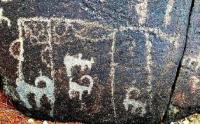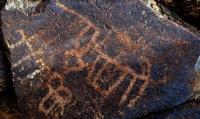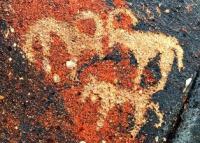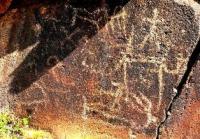You are here
Petroglyphs of Central Kazakhstan.




Petroglyphs Tours in Central Kazahtsan.
“Ancient aphorisms outlived centuries. Modern aphorisms can barеly survive from book to book”
Ljupka Cvetanova.
Museum Petroglyphs Tours in Kaaraganda.
The middle part of Kazakhstan is occupied by a vast mountainous and steppe country – Saryarka (Kazakh Uplands). The unique landscape of Saryarka houses material evidence of the region’s ancient history left by ancient Stone Age hunters and Neolithic people, by shepherds and metal makers and by nomadic tribes from the Early Iron Age, Middle Ages, and modernity.
The evidence includes rock drawings, although such sites are less numerous on the map of the central part of Kazakhstan. The area of the main watershed Saryarka is mostly represented by mountain rocks not very suitable for engraving.
Those preserved are on isolated rocks at a great distance from one another, mainly on relatively smooth granites and diorites enclosed by natural ledges. Dravert P.L. Grotto in the Bayanaul Mountains is a famous rock art site, discovered in 1926 on the south-eastern shore of Zhasybay Lake by a Russian geologist and poet, after whom it was named.
everal humans facing the entrance of the cave were painted in ochre on its roof, so they could be seen from the depths of the niche. Paintings similar in contents and technique were also discovered later in other shelters in forested areas of the lake.
The main motifs on the walls and roofs include humans, but also isolated animals, birds, a bow with an arrow and unsophisticated geometric shapes or signs. It is difficult to date them; it is unlikely that most would date beyond the Bronze Age, a period of active peopling of the area with Andronovo and Begazy-Dandybaev culture tribes.
Rock paintings in central Saryarka were also made in another remarkable site – Tesiktas Grotto– located in the spurs of the Kyzyltau Mountains, in the upper reaches of one of the Sherubay-Nura River tributaries, far from Lake Bayanaul.
Although the natural environment is quite similar, Tesiktas represents a different type of landscape and rock paintings. Petroglyphs in Akbidayik and Olenty in the north-eastern periphery of Saryarka – a rare type of archeological site for the area – are among the northernmost rock art sites in Kazakhstan.
They represent the earliest examples of steppe-tribes’ rock art from the 3rd to the first half of the 2nd millennium BC, which permits us to trace some pictorial traditions of the Bronze Age common in the southern regions of Saryarka (Northern Near Balkhash Area, Ulytau) and farther in the Karatau and Chu-Ili Mountains.
Terekty Aulie, 90km east of Zhezkazgan City and 20km north-west of Terekty Station in the Karagandy Region, is a remarkable rock art site in the south-west of Saryarka. It is small, both in terms of the space occupied and its number of petroglyphs on granite.
The main series of Bronze Age petroglyphs is homogeneous and special. Many archeological sites belong to different periods, with Paleolithic, Neolithic and Bronze Age dwelling sites, Early Iron Age kurgans, remains of mining activities, a necropolis with medieval and XVIIIth - XIXth mausoleums.
Terekty Aulie is one of the few rock art sites in Kazakhstan where rocks with ancient petroglyphs are part of a cycle of religious and cultic worship. The most ancient petroglyphs favor horse images. There are also two-humped Bactrian camels, bulls, goats, deer, snakes, a feline predator and a chariot.
The integrity of the iconography and style of this Terekty Aulie rock art, attributed to the Seymin-Turbin pictorial traditions from parallels with items of those cultures, serves to identify rock art sites in the southwest of Saryarka (Baykonur Valley), south Kazakhstan (Karatau) and Central Asia (Fergana).
A vast mountainous semi-desert exists from the Northern Near Balkhash area to the south of the main watershed of Sary-Arka (Kazakh Uplands). The harsh weather of this practically impassable region has preserved some remarkable ancient sites including petroglyphs.
Some were discovered in the 1960’s by Margulan A.H., geologists Medoev A.G. and Aubekerov B.Zh. and studied in 2007 by Rogozhinskiy A.-E., but, in general, this area of Kazakhstan is considered as poorly Rock Art in Central Asia 32 researched.
Two famous sites – Besoba and Kalmakemel – are good examples of the rock art in the Northern Near Balkhash Area.
Authority:
“Rock Art Sites in Kazakhstan”. Alexey E. Rogozhinskiy.
Photos by
Alexander Petrov.







